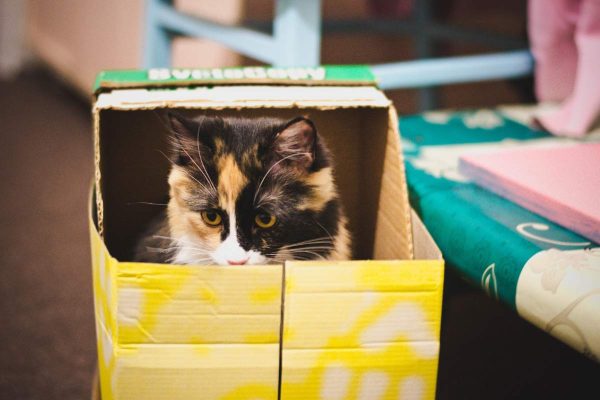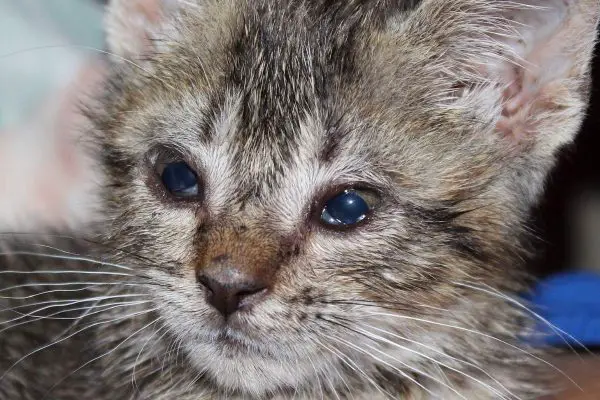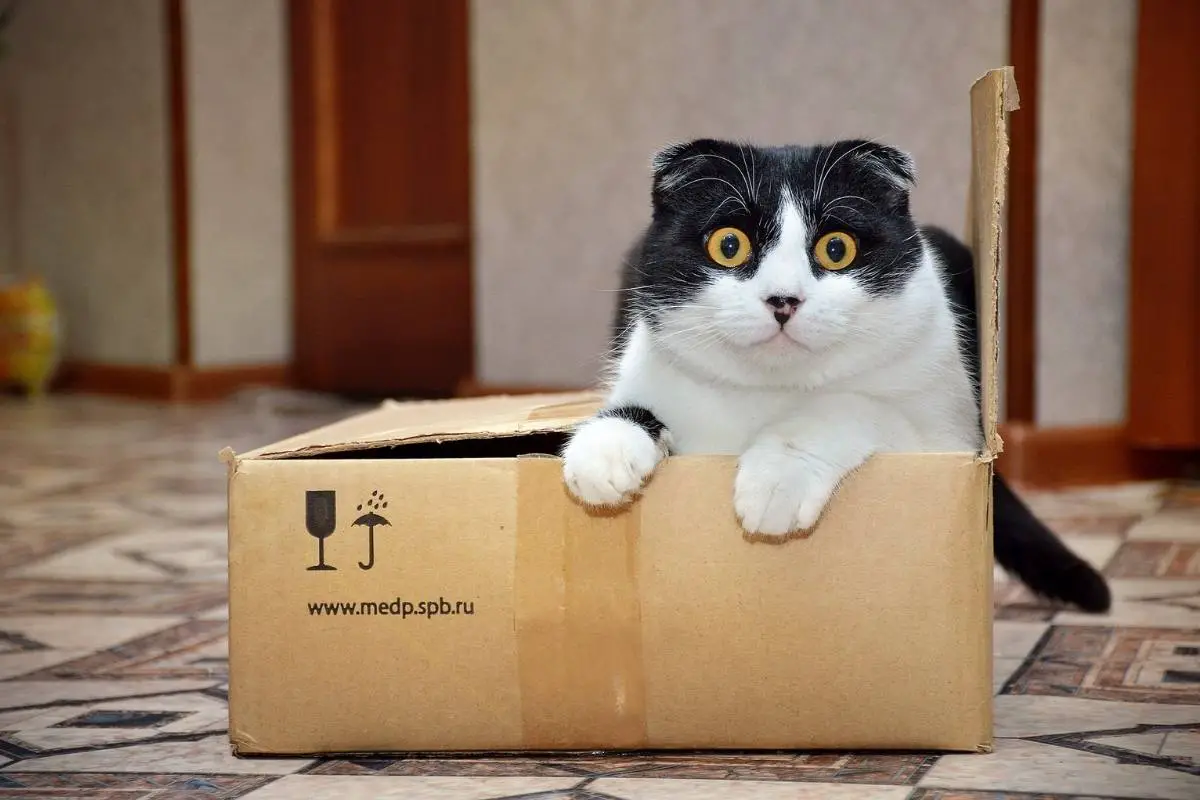Cats have a primal instinct to rip apart and play with their prey. This can explain why cats will shred items like cardboard with their nails or teeth, as it helps them relax and is a form of play when they have a lot of energy. However, the destruction and ingestion of cardboard and other non-food items can be a sign that your cat is experiencing some sort of discomfort.
So, why does my cat destroy cardboard boxes? While, for many cats, the destruction of cardboard boxes is a form of relaxation and play, this behavior is most likely a sign of a bigger problem, like discomfort and dissatisfaction, or a health concern like Pica.
This article covers the variety of reasons that a cat may destroy cardboard boxes in your home, including entertainment, discomfort, hunger or picky eating, dental issues, and Pica. This article will also explore solutions to this problematic behavior with your cat’s health and well-being in mind.
Entertainment

Before jumping to the conclusion that your cat is ill, instead consider that your cat is destroying cardboard for entertainment and self-relaxation. Environmental factors in a cat’s life may cause boredom and lead the cat to seek attention in inappropriate ways, like destroying household objects such as cardboard boxes.
This behavior falls in the realm of normalcy for most cats. Your cat may simply enjoy the texture of corrugated cardboard, and use cardboard boxes around the house as a scratching post to dull their nails and relieve stress.
If you suspect that this is the case, invest in a corrugated cardboard scratching post for your cat. Some cardboard scratching posts even come loaded with dried catnip, which will encourage your cat to destroy the intended scratching post over a standard cardboard box.
It is not uncommon for a cat to chew lightly on the edges of their scratching post, so don’t be alarmed if you see this happening, unless you suspect that your cat is ingesting the cardboard.
Some cats also enjoy hanging out in enclosed spaces like cardboard boxes, and may tear apart or chew on the box while resting there. If this is the case, invest in a sturdier and more permanent box for your cat, like a wooden one. Wooden boxes offer the same enclosed space that your cat may enjoy without the danger of your cat ingesting any non-food material.
Discomfort or Dissatisfaction
Your cat’s tendency to destroy cardboard boxes could also be their way of communicating some sort of discomfort or displeasure they are experiencing. Your cat could be hungry or a picky eater, experiencing dental problems, or have stress or anxiety that is causing them to behave inappropriately.
Hunger or Picky Eating
Your cat’s discomfort could be explained by something as simple as hunger or picky eating. Some cats will refuse to eat if they aren’t given the food they prefer, and may resort to chewing on cardboard as a way to communicate this dissatisfaction to their owner.
While this behavioral trait can be annoying for a cat owner, it can be useful in identifying problems in your cat’s eating patterns, and can give clues as to whether or not your cat has had enough to eat. To prevent malnutrition, avoid feeding your cat food with fillers, and opt for higher-grade cat food.
Dental Problems
Cats may also chew on cardboard when their gums are sore. Many cats start to develop dental problems like gingivitis by age 3, and may chew on soft objects like cardboard to soothe sore gums of pain and inflammation.
If you suspect this is the case with your cat, you can avoid further dental problems by ensuring your cat has the proper toys to chew on, brushing their teeth regularly, and getting regular dental checkups at the vet.
Stress or Anxiety

A cat may also destroy cardboard boxes as a way of communicating stress, anxiety, anger, or upset. Cats often seek attention from their owners when they are dissatisfied or upset by taking out their anger on inanimate objects.
In these cases, it’s important not to reward your cat for their destructive attention-seeking behavior, as doing so will only encourage the cat to continue seeking attention in the same way. Instead, make an effort to play with your cat more regularly; they may simply be lonely or under-stimulated.
If your cat needs more attention than you can give, consider getting them a playmate. While a playmate will not resolve all behavioral issues, it will provide an opportunity for your cat to refocus their energy on their playmate, and burn off extra energy through play.
Pica in Cats
If your cat is ingesting the cardboard that they destroy, it could be a sign that they are afflicted with Pica. Pica is a feline eating disorder that gives cats the urge to eat soft, non-food materials like cardboard, wool, plastic, or even litter.
Pica can be caused by a number of problems, including a dietary deficiency like anemia, medical problems like feline leukemia or FIV, or a compulsive disorder caused by early weaning.
Identifying a Health Issue
It may not always be obvious that a cat is eating foreign objects—if you are unable to catch your cat in the act, investigate their litter box. Ingested foreign objects will be commonly visible in your cat’s litter, as your cat won’t be able to digest it.
There are a number of medical issues related to Pica, so it is recommended that you bring your cat to the vet if you notice them eating non-food objects. Ingesting cardboard and other non-food objects can cause an intestinal blockage.
In many cases, your cat’s propensity for destruction could be related to boredom, stress, or anxiety, and the vet will be able to rule out Pica as a medical concern.
Other Health Concerns
Anemia

If your cat is afflicted with Pica, it is important to be aware of the number of medical issues that are associated with it, like anemia or diabetes. Anemia in cats can be caused by kidney failure, feline HIV, leukemia, cancer, poor nutrition, or starvation.
Diabetes
While the percentage of cats with diabetes is less than 2%, diabetes can be related to Pica, and is usually caused by the food you feed your cat. Most vets would recommend that you avoid cat food with fillers, and instead look for higher-grade food. While it may be more expensive to feed your cat higher-grade food, doing so can result in a better life expectancy for your furry friend.
Resolving Behavioral Issues
Pica in cats can also be explained by a number of non-medical issues like boredom, stress or anxiety, and learned behavior. It is not uncommon for a house cat to be under-stimulated.
Boredom and lack of stimulation in cats can be resolved by playing actively with the cat, or investing in passive toys to leave around the house. If your cat is experiencing stress or anxiety, make sure that there are dedicated spaces in the house for your cat to hide when they are feeling over-stimulated.
Some cats are responsive to soft, passive music, so consider playing some to calm your cat when you notice they are feeling stressed or anxious.
Conclusion
The most sure-fire way dissuade your cat from destroying and ingesting cardboard and other non-food objects is to remove or hide targeted items in your home, and replace those objects with safer, more appropriate options for your cat to chew on, like soft, cloth-made cat toys.
If you cannot hide or dispose of the cardboard boxes in your home, make them unappealing by applying strong-smelling scents, like citrus air freshener or spray. Cats are very sensitive to smell, especially citrus scents, so this can be an effective measure to take to deter your cat from destroying cardboard boxes.
Some cats may simply be bored or lonely, so making more time to actively play with your cat if they are asking for attention is another way to discourage them from inappropriate behaviors like destroying cardboard boxes.
If none of these measures effectively dissuade your cat from destroying cardboard boxes, consider talking to an animal behaviorist. If your cat is still eating non-food items, but does not show signs of medical problems like Pica, look for a certified animal behaviorist.
Most animal behaviorists can work closely with your vet to develop specialized solutions to your cat’s behavior problem.

